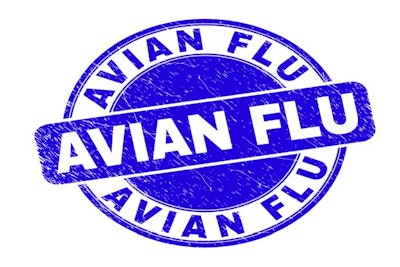
After a month-long period without any new highly pathogenic avian influenza (HPAI) cases in commercial poultry, France has begun lifting disease control measures.
Back in November of last year, the agriculture ministry announced that all poultry must be kept housed. With this, the aim was to keep domestic birds out of contact with wild species that were responsible for spreading the virus.
In mid-April, the ministry lifted some of the restrictions put in place last winter. The move was justified, it said, because the avian flu situation had stabilized in poultry.
Mandatory housing of poultry has been lifted nationwide — apart from a few remaining pockets where the risk of HPAI remains high. Specifically, domestic ducks and geese can be allowed access to outside areas, providing these are adapted to minimize the risk of contact with wild birds. From the bird welfare point of view, this is important with the approach of the warmer summer months. Despite this easing of restrictions, the authority stresses the need for producers to maintain high levels of biosecurity and vigilance around their flocks.
Furthermore, the ministry has announced a 50% reduction in the frequency of disease surveillance in waterfowl flocks. This applies to Pays de la Loire and Brittany — regions in the west and north-west of France, respectively — and to the southwestern department of Deux-Sèvres. These areas were particularly hard hit by HPAI in the past “season.”
Since the start of 2022-2033 winter, there have been 314 confirmed outbreaks on poultry farms in mainland France, according to the ministry. All were linked to the H5N1 serotype of the HPAI virus.
In other poultry and in wild birds, the same source reports an unchanged number of outbreaks at 86. However, in its latest statement, the agriculture ministry stresses that new cases of H5N1 infection continue to be detected among the country’s wild bird population.
Europe’s wild bird outbreak total this year approaches 1,900
So far this year, a total of 1,893 outbreaks of HPAI have been confirmed in 23 European Union member states. This is according to the latest update of the Animal Disease Information System of the European Commission (EC; as of April 21). The total is 33 higher than the previous report dated seven days previously.
With 563 since the start of January, Germany has confirmed the most outbreaks in this category. France’s total has risen to 299, followed by the Netherlands (207), Italy (167), Belgium (148), Switzerland (122), Austria (111), and Denmark (61).
Also officially confirming new cases of HPAI in wild birds with the EC over the past 14 days have been the Czech Republic, Hungary, Republic of Ireland, Lithuania, Poland, Spain, Sweden, and United Kingdom (U.K.). This is based on notifications from the respective national veterinary authorities to the World Organisation for Animal Health (WOAH).
Further HPAI outbreaks on European poultry farms
In Denmark, a mandatory housing ban for poultry was also lifted in mid-April. According to the Danish Veterinary and Food Administration, this is because of a lower risk of HPAI. Relaxation of the rules also means that poultry shows can now resume.
As if to demonstrate that the HPAI threat has not passed, the same agency announced an HPAI outbreak at a commercial poultry farm just seven days later. Presence of the H5N1 HPAI virus was confirmed in a housed flock of around 30,000 chickens in Augustenborg. Around 1,000 of the breeding hens died at the premises in Southern Denmark, according to the WOAH notification, and the rest were to be culled.
This was the country’s fourth HPAI outbreak so far this year.
Over the past two weeks, Hungary’s animal health agency has registered 11 more outbreaks on poultry farms. All the infected premises were in the southern counties of Backs-Kiskun or Csongrad-Csanad, where around 160 outbreaks have been reported since November of last year.
In Italy, the number of outbreaks linked to the same virus in 2023 has risen to 10. This is according to the national health authority and research organization for animal health and food safety, IZSVe. Of the most recent outbreaks, two were in backyard flocks (in Lombardy and Emilia-Romagna), and one affected an unreported number of meat turkeys in the Veneto region, according to the WOAH report.
During April, authorities in the U.K. also ended the mandatory poultry housing ban (with a few exceptions).
Over the past two weeks, two new outbreaks on commercial farms were reported to WOAH. Affected were a flock of 32,000 laying hens in Powys (Wales) and one with around 2,700 meat ducks in the northern English county of Yorkshire.
Since then, the agriculture department, Defra, has confirmed a further four outbreaks — two more in Powys, and one each in Yorkshire and Northamptonshire in the East Midlands of England.
To WOAH, the animal health agency of the Czech Republic (Czechia) has announced the HPAI situation in poultry “resolved.” During the months of December and January, six outbreaks were linked to the H5N1 virus serotype. Directly impacted through mortality or culling were almost 809,000 poultry.
Further outbreaks recorded in Europe’s captive birds
Over the past two weeks, the Norwegian veterinary authority has confirmed with WOAH two outbreaks of HPAI in captive birds.
Affected were a total of 15 birds, including one city park flock in Møre & Romsdal, and captive birds in Vestland. Both counties are located in the region of Western Norway.
Meanwhile, the Faeroe Islands have declared to WOAH that the earlier HPAI outbreak series is closed. Between May and October of 2022, 14 outbreaks were confirmed in the territory. Of these, one involved around 120 domestic birds, while the others were in wild species.
As of April 21, 11 European nations have notified the EC’s System of HPAI cases in “captive birds” since the start of 2022. Covering backyard and hobby poultry flocks as well as premises such as zoos, the total stands at 81 across the region for the year so far.
Affected since the start of January have been 29 premises in Germany, 25 in France, and 11 in Belgium. There have been no more than four confirmed outbreaks in each of the other countries.
HPAI infections in animals other than birds
In mid-April, four more red foxes in Belgium tested positive for the H5N1 HPAI virus, according to a recent WOAH notification.
Around one month earlier, Defra reported that 10 wild dogs were found to be infected with the same virus. All of them died or were euthanized. They belonged to a group of 15 South American bush dogs kept at a zoo in England as part of a captive animal breeding program.
View our continuing coverage of the global avian influenza situation.















